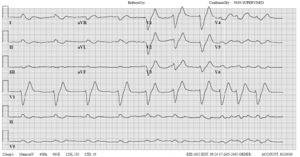The Ions Have It: Difference between revisions
Jump to navigation
Jump to search
m (New page: {{NHJ| |mainauthor= '''A.A.M. Wilde, R.B.A. van den Brink''' |edition= 2005:11,428 }} Figure 1|thumb A46-year-old male was admitted to our emergency ...) |
mNo edit summary |
||
| Line 18: | Line 18: | ||
[[Puzzle 2005_11_428 - Answer|Answer]] | [[Puzzle 2005_11_428 - Answer|Answer]] | ||
Revision as of 17:31, 8 October 2007
| Author(s) | A.A.M. Wilde, R.B.A. van den Brink | |
| NHJ edition: | 2005:11,428 | |
| These Rhythm Puzzles have been published in the Netherlands Heart Journal and are reproduced here under the prevailing creative commons license with permission from the publisher, Bohn Stafleu Van Loghum. | ||
| The ECG can be enlarged twice by clicking on the image and it's first enlargement | ||
A46-year-old male was admitted to our emergency room with dyspnoea. His medical history included congestive heart failure with a left ventricular ejection fraction of under 10%, type II diabetes, gout, hypothyroidism and morbid obesity. Physical examination was severely hampered by the patient’s weight (in excess of 230 kg), but revealed signs of right and left heart failure. The ECG on admission is shown in figure 1.
What diagnosis does it suggest, what further information do you need, and how should the patient be treated?
